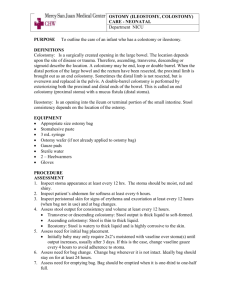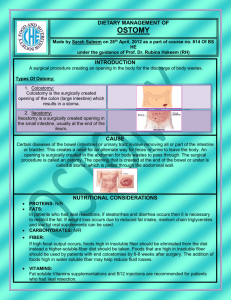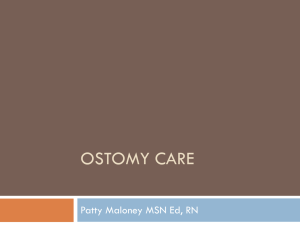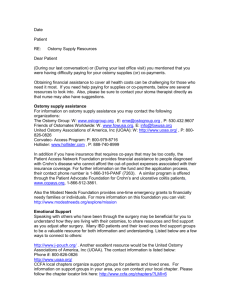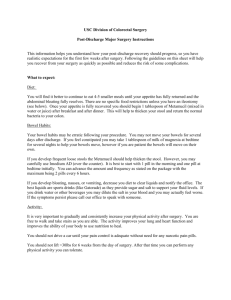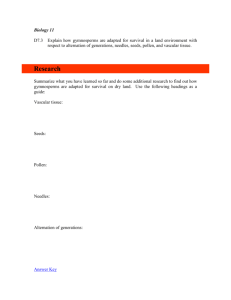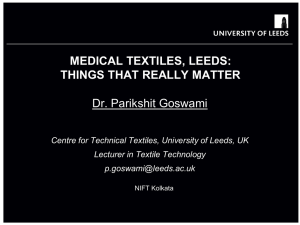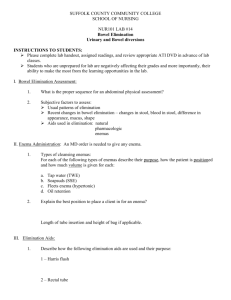Access to Ostomy Supplies and Innovation
advertisement
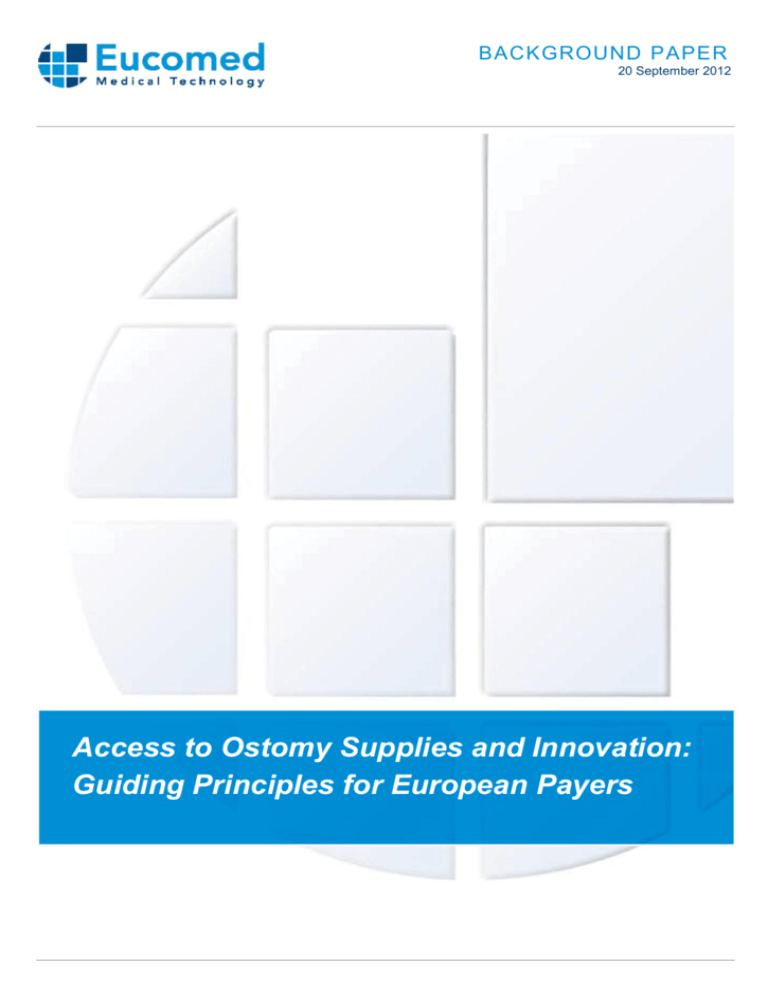
BACKGROUND PAPER 20 September 2012 Access to Ostomy Supplies and Innovation: Guiding Principles for European Payers 1 Contents Preamble ................................................................................................................................................. 3 Background on Ostomy Surgery ............................................................................................................. 4 Moderately Protruding Stoma .......................................................................................................... 4 Flush Stoma..................................................................................................................................... 4 Long Stoma ..................................................................................................................................... 5 Colostomies ..................................................................................................................................... 5 Summary of Colostomy Type and Status ........................................................................................ 6 Ileostomies....................................................................................................................................... 6 Summary of Ileostomy Type and Status ......................................................................................... 7 Urostomies....................................................................................................................................... 8 Summary of Urinary Stomas ........................................................................................................... 8 Peristomal Skin Complications ........................................................................................................ 8 Physical Concerns ......................................................................................................................... 15 European demographic data ................................................................................................................. 16 Ostomy care in the EU will be viewed in the context of the following: .................................................. 17 Eucomed Guiding Principles for Access to Ostomy Supplies and Innovation ...................................... 18 About Eucomed ..................................................................................................................................... 19 2 Preamble 1 Continence, the ability to retain bodily discharge voluntarily is one of the first “rites of passage” for humans on the way to adulthood. For most of us, continence is such a basic, natural state that it is generally taken for granted. However, for approximately 700,000 citizens of the European Union, this is not the case. As a result of disease, genetics or trauma, these individuals have undergone ostomy surgery to remove diseased or damaged portions of their intestines or bladder. This being a life-saving procedure, ostomy surgery often results in a loss of sphincter control and redirects the output from the intestinal or urinary system to a surgically-created opening on the abdomen called a stoma. Unfortunately, patients have little or no control over the functioning of the stoma opening. While they are “cured” of their disease, people with an ostomy are also incontinent and must for the remainder of their lives wear an external skin barrier to protect their skin and, attached to the skin barrier, a prosthetic pouch (bag) to collect the effluent. The loss of continence as a result of ostomy surgery is a life-changing experience. While patients’ health generally improves significantly after surgery, psychological, social, work-related and sexual issues remain. Access to the ostomy supplies that are prescribed and customised to the individual is critical to maintaining health and well-being. Access to new innovations that provide enhanced skin protection and/or prosthetic functionality is critically important for these individuals. The purpose of this paper is to educate and heighten awareness of ostomy surgeries and the medical complications that can arise when people living with the effects of stoma surgery lack full access to the ostomy supplies they continuously need. It identifies the access issues currently experienced by ostomates within the EU and lays out a set of guiding principles for government, payers and regulators to follow to ensure every ostomate has access to these life-saving medical devices. It is hoped that this paper will facilitate constructive stakeholders’ dialogue, ensure representation of ostomates, clinicians, payers, policymakers, the industry, and promote efficient collaboration in finding the best solutions towards ensuring universal access to products that fit their individual needs. 1 http://www.merriam-webster.com/dictionary/continence 3 Background on Ostomy Surgery 2 An ostomy is simply defined as an opening. The term ostomy is used interchangeably with the term stoma, which is defined as a mouth or opening between cavities or between a cavity and the surface of the body. For our purposes, an ostomy/stoma is created to reroute the elimination of the body’s waste products to the surface of the abdomen. Surgery to create an ostomy is required when there is a malfunction within the gastrointestinal or urinary systems. When ostomy surgery is performed, a stoma is created at the surface of the abdominal wall. In the case of a gastrointestinal ostomy, an opening is made in the abdominal wall and the proximal (closest to the stomach) end of the intestine is pulled through, and then turned back on itself to create a stoma. The newly created stoma is then sutured in place to prevent it from slipping back through the abdominal wall. Creation of a stoma diverts the faecal or urinary flow to allow the distal (closest to the rectum) portion of the intestine or bladder to rest, be treated or be removed. Stomas created within the GI tract can be permanent or temporary. If the physician diagnoses that the process that caused the need for an ostomy can be resolved, the distal (closest to the rectum) portion of the intestine will not be removed. This allows for it to be reattached at a later time. When looking at a stoma you are seeing the inside of the intestinal wall. It should have a pinkish-red colour and be moist, much like the inside of your cheek. The diameter of the stoma may be 1.27cm to 7.62cm (½” to 3”) or larger. This is dependent on the type of ostomy, size of the patient, and the amount of swelling after surgery. The shape of the stoma may be round, oval or irregular. Moderately Protruding Stoma When a surgeon creates a stoma, he or she will attempt to leave approximately 2.54cm (1”) of intestine protruding from the abdominal wall. This allows for easier management of the stoma (meaning waste products are easily collected in the ostomy pouch, in most cases without the complication of skin breakdown). Flush Stoma On some occasions, due to an obese abdomen or scarring from previous surgeries, the surgeon is unable to bring enough intestine to the surface to protrude. This is called a flush stoma because it does not protrude from the abdomen. A normally protruding stoma can also become flush over time if a person gains weight or if scarring occurs during the healing process. 2 Content and photos for this section is courtesy of ConvaTec Inc. 4 Long Stoma On other occasions, a longer portion of the bowel may protrude. This is called a long stoma. A long stoma provides for proper drainage of waste products from the body, but may be aesthetically unpleasant. It may also be difficult to manage because the stoma must be hand-guided into a pouch and wrapped in gauze while cleaning the peristomal skin. Also the stoma is at greater risk of physical injury. Flush stoma - Moderately protruding stoma - Long stoma Colostomies A Colostomy is an opening made in the colon (large intestine) for the purpose of removing waste materials from the body. A colostomy is created by first surgically cutting the colon in two (with the exception of the Loop Colostomy, which will be discussed later). Then, the proximal portion of the colon is brought through the wall of the abdomen and a stoma is created. The distal portion of the colon, which is still attached to the rectum, may be completely removed and the rectum sutured closed. This type of colostomy is called a permanent colostomy. If the physician feels it is possible to resolve the process that created the need for the colostomy, the distal portion of the colon will not be removed. This type of colostomy is called a temporary colostomy. The distal portion of the colon will be reattached in the future, if possible. However, it is often the case that these ‘temporary’ ostomies are never reversed and essentially become permanent. Colostomies can be created for several reasons, including: Cancer: An unregulated, disorganised proliferation of cell growth. Cancer of the colon and rectum is the second most common type of cancer in adults. Congenital anomalies: An irregularity of the gastrointestinal tract found at birth. Obstruction: Blockage of the flow of effluent through the gastrointestinal tract. Diverticulitis: Inflammation of diverticulosis, small out-pouchings of the intestinal mucosa that protrude to the exterior of the colon through weakened points in the muscular layer. 5 Trauma: Traumatic injury to the gastrointestinal tract due to a penetrating wound, such as a gunshot or stab wound. A colostomy is named according to where in the colon it is placed. Summary of Colostomy Type and Status Type of Colostomy Permanent or Temporary? Cecostomy Permanent Ascending Colostomy Permanent Loop Colostomy Temporary Double Barrel Colostomy Temporary or Permanent Sigmoid Colostomy Permanent Ileostomies An ileostomy is a surgically-created opening in the ileum for the purpose of removing waste materials from the body. As in the creation of a colostomy, the ileum is surgically cut into two pieces, usually as close to the end of the ileum as possible. The proximal portion of the ileum is brought to the surface of the abdomen and a stoma is created. In most cases the distal ileum and the entire colon are then removed. Occasionally the remaining ileum and colon are maintained for reattachment later (e.g. J pouch). The greater the length of small intestine removed, the greater the loss of nutrient absorption. This can result in nutritional deficiencies that will require adjustments in the patient’s dietary and fluid intake. Since the colon has also been removed, the water and electrolyte absorption is compromised, placing the patient at risk of developing fluid and electrolyte imbalances. Careful monitoring of these 6 patients is required initially. Over time, the remaining ileum will adapt and take over part of the absorptive capabilities of the colon. An ileostomy may be created for several reasons: Crohn’s disease: An inflammatory disease that affects all layers of the bowel wall and can affect any part of the gastrointestinal tract, most frequently the distal ileum and colon. Chronic ulcerative colitis: A chronic mucosal inflammation. It is limited to the colon. Inflammatory bowel disease: A term that encompasses several different inflammatory diseases of the gastrointestinal tract, including ulcerative colitis and Crohn’s disease. Cancer Congenital anomalies Familial polyposis: A hereditary precancerous condition. Trauma Output from an ileostomy is liquid or pasty in consistency and occurs several times a day, usually after a meal. It has a high pancreatic enzyme content, which makes it highly irritating to the skin. Ileostomies can be continent or incontinent. An incontinent ileostomy will secrete waste products from the stoma randomly throughout the day. The patient will have no real control over when the waste products will be expelled and therefore will require a continuous pouching system. The incontinent ileostomy is the most common type. A continent ileostomy allows the patient to control when the waste products will be expelled. One type of continent ileostomy is known as the “Kock Pouch” named for the Swedish surgeon who created the procedure. This type of continent ileostomy is created when an internal pouch is constructed using the small bowel. A valve is then created at the point where the pouch meets the abdominal wall. This valve prevents waste products from being excreted until the patient chooses to do so. This type of surgery is no longer a preferred choice, as research shows a high incidence of valve failures, resulting in leakage of stool or urine from the reservoir. Another type of continent ileostomy is the ileoanal reservoir. For this type of ileostomy the diseased colon and mucosa of the rectum are removed, but the anal sphincter muscles are left intact. A portion of the ileum is then used to create a reservoir or pouch and is anastomosed (surgically connected) to the remaining rectum. This allows for the use of the anal sphincter muscles, thus preserving continence. Only persons diagnosed with an ulcerative colitis will be offered this type of surgery. Summary of Ileostomy Type and Status Type of Ileostomy Ileostomy Function Ileostomy (incontinent) No control over effluent – continuous pouching required Internal pouch at abdominal wall emptied via catheter 3-4 times a day Portion of ileum used to create a pouch attached to rectum – 4-8 bowel movements a day Continent ileostomy (Kock Pouch) Ileoanal reservoir 7 Urostomies A urostomy or urinary diversion is a general term applied when the bladder is removed or the normal structures are being bypassed and an opening is made in the urinary system to divert urine. Similar to the creation of a gastrointestinal ostomy, the flow of urine is diverted through an opening in the abdominal wall. With incontinent urinary diversions, urine seeps continuously, thus a pouch or collection device is required. This pouch or collection device must also be designed to prevent the reflux of urine to the stoma. This prevents urine crystallisation around the stoma, reduces risk of infection, and assists in the prevention of skin breakdown. In addition, patients with urinary diversions are encouraged to adjust their dietary intake to create an acidic urine pH. This reduces bacterial proliferation and crystal formation on and around the stoma. Urinary diversions are performed for several reasons: Cancer Chronic infections of the urinary tract Congenital anomalies: An irregularity of the urinary system found at birth, such as spina bifida, meningomyelocele and bladder extrophy. Spina bifida: A congenital defect in the fusion of the bony spine associated with gastrointestinal and urinary dysfunction. Meningomyelocele: A congenital condition in which the sac surrounding the spinal cord is formed outside the body. Bladder extrophy: A congenital condition where the bladder is formed outside the body. Neurogenic bladder: Normal nerve stimulation of the bladder is cut off. Paralysis: Loss of movement and sensation, usually due to spinal cord trauma. Trauma Summary of Urinary Stomas Type of Urostomy Urostomy Function Ileal conduit Urinary stoma on abdomen created from ureters attached to a piece of ileum – permanent Urinary stoma of ureter through abdominal wall and flank – permanent Tubes placed in kidney to drain urine through abdominal wall – usually temporary to bypass ureter obstruction A tube placed from bladder to abdominal wall for draining urine – temporary or permanent Ureterostomy Nephrostomy Cystostomy Peristomal Skin Complications Peristomal Skin Irritation is the most common type of problem associated with having a stoma and is usually caused by an improperly fitted skin barrier. The skin barrier is designed to protect the skin from the waste products. An improperly fitted skin barrier allows waste products to come in contact with the skin, which results in irritation and, eventually, skin breakdown. The peristomal skin appears reddened (erythema) or inflamed and may be weepy and/or bleeding. Skin irritation can also occur when a skin barrier is not securely attached to the skin surface or when dips, creases or scars are present on the 8 abdomen causing an uneven skin surface, which allows tunnelling of the waste products under the skin barrier. Treatment is directed at eliminating the cause of the irritation. If an improperly fitted skin barrier is the cause, it should be adjusted to fit the stoma properly. If dips, creases or scars are present, a paste product or other skin barrier seal product will be used to fill in these areas and create a flat surface for the skin barrier to adhere to. If the irritation has progressed to the point of actual skin breakdown, it is necessary to create a dry surface for the barrier to adhere to. This is accomplished by the use of a topical powder over the affected area. Peristomal skin irritation Tape reaction (allergic contact dermatitis) Peristomal skin irritation may, on rare occasions, also be caused by an allergic reaction to skin barrier ingredients or pouch materials. This appears as a reddened area where the skin and the barrier or pouch comes into contact. The patient will experience itching, burning or stinging, and there may be areas of moist, eroded and denuded skin. Treatment involves defining the allergen and replacement of the skin barrier or pouch that is causing the irritation. Allergic contact dermatitis 9 Skin stripping Skin stripping is caused by the improper removal of a skin barrier or adhesive tape. The peristomal skin will appear reddened or inflamed; it may be weepy and have areas of bleeding. Treatment involves instructing the patient in the proper removal of the skin barrier. If frequent removal of the skin barrier is required, a skin barrier developed for daily removal should be chosen. Skin stripping Candida infections (yeast infections) Many ostomy patients are at risk for Candida albicans infection, or what is commonly known as a “yeast infection”. This is because the peristomal skin is usually warm, moist and covered which creates a good environment for yeast to grow. The skin will appear reddened (erythematous) and will itch. Treatment includes the application of a topical antifungal over the affected area. Candida infection 10 Folliculitis Folliculitis is caused by the removal of hair from its follicles by aggressive adhesives. This results in irritation or infection. It appears as reddened areas of the base of the hair follicles around the stoma. Folliculitis Epidermal hyperplasia (thickened skin) Epidermal hyperplasia is caused by the repeated exposure of the peristomal skin to urine due to an excessively large opening in the skin barrier. It appears as thickened, wart-like skin in the peristomal area. Epidermal hyperplasia 11 Alkaline encrustation (urine crystal formation) Alkaline encrustation is caused by an alkaline urine with a pH of greater than 5.5. It appears as white, gritty, crystalline deposits on the stoma, peristomal skin and/or lining of pouch. Alkaline encrustation Peristomal hernia A peristomal hernia is a protrusion of the intestine through the abdominal muscles to the area beneath the peristomal skin. It is caused by weakened abdominal muscles or inadequate surgical suturing. Treatment requires surgery if the blood supply is impaired. Peristomal hernia 12 Prolapse A prolapsed stoma is when an abnormally long portion of the intestine extends through the abdominal opening. It can be caused by weakened abdominal muscles, an oversized opening, or the disruption of internal attachments securing the bowel. It may develop gradually but then becomes complete by sudden increased abdominal pressure during strenuous activity or sneezing. Prolapse stoma Retraction A retracted stoma occurs when the intestine is drawn back into the abdomen and shortens the end of the bowel, which forms the stoma. It is caused by breaking sutures, significant weight gain, formation of scar tissue, or shrinking of the stoma. Treatment requires surgery if impaired function of the stoma results. Retracted Stoma 13 Necrosis A necrotic stoma is caused by a deficient blood supply. The stoma assumes a dusky, dark purple colour, unlike the healthy red colour of normal mucosa. The only treatment is surgical revision to debride all necrotic (dead) tissue and create a stoma from a fresh area of intestine with a good blood supply. Necrosis Stenosis Stenosis is the narrowing or constriction of the stomal opening. It is caused by a scar tissue formation that develops gradually. Treatment involves surgical reconstruction. Stenosis 14 Physical Concerns Flatulence (gas) Flatulence is caused by certain foods and the swallowing of air when we talk, eat, smoke, etc. In the first few weeks after surgery, the patient may experience a greater output of gas than usual because of the adjustment in his or her diet. After resuming a normal diet, this is less of a problem, yet many people continue to modify their dietary intake to further reduce gas production. Odour The odour associated with stools is caused by the normal bacterial activity that takes place within the bowel. The degree of odour is related to: foods (such as onions, pickles, and eggs), medications, ostomy dysfunction or obstruction from recurrent disease. Management includes avoiding certain foods, changing medications, and using pouch deodorants. Constipation Constipation, the difficult or infrequent passage of faeces, can be a problem for patients with colostomies. It may be caused by foods, medications, or lack of fibre and fluid intake. Diarrhoea Diarrhoea, defined as increased volume, fluidity or frequency of faeces relative to the usual pattern for an individual, can also occur. Increased loss of fluid and electrolytes can result from surgical resection of the bowel, particularly in the case of ileostomy surgery. Management includes the adjustment of dietary habits to prevent this problem. It is particularly important to maintain adequate fluid intake to prevent dehydration. Prolonged diarrhoea should be reported to a physician, who should investigate the cause of the underlying disorder. Anti-diarrhoeal medications may be used, but only under physician supervision. Dietary considerations Foods that create digestive problems before surgery should be avoided after surgery as well. For the person with an ileostomy, foods should be chewed thoroughly because difficult-to-digest foods, such as broccoli, cabbage etc. can pass through the remaining small intestine intact and cause a food blockage. For this reason, high-fibre and high-cellulose foods should be gradually added to the diet. Emotional concerns Physical problems can usually be solved through changes or modifications in supplied diet and medication. Emotional concerns are not as easily alleviated. Most ostomy patients will pass through several emotional stages as they gradually adapt to their ostomy. The individual’s fear of rejection, threatened changes in lifestyle and body image, and social concerns (such as employment, sex, pregnancy, daily activities) will all have a major impact on rehabilitation after ostomy surgery. The rehabilitation period an ostomate goes through will vary with the individual, but certain influences seem to promote emotional health: Visits from others who have experienced the same type of surgery. Adequate instructions and counselling from the enterostomal therapy (ET) or ostomy nurse. Positive support from family members or significant others, as well as the medical staff. A pouching system that allows the person to prevent accidents and to control odour and noise. Freedom from ostomy management problems. 15 European demographic data In January 2011, Eucomed engaged in an industry survey of ostomy patient demographics and prevalence and incidence of ostomy surgeries across Europe. Because ostomy surgeries are not, generally, high profile procedures among payers, there is an absence of publically reported data on ostomy patient characteristics as well as the number and types of ostomy surgeries performed across Europe. Despite this, there is a need for high quality data in this area in order to understand and frame the issues faced by people with an ostomy. In the absence of data from the European Commission or Member States, it was determined that industry’s market research and planning assumptions represented the best source of this data. Recognising that each company’s data sources were different, Eucomed engaged in an extensive survey of ostomy manufacturers, which included Coloplast, ConvaTec and Hollister, and then averaged the pooled results to reveal a consensus overview of the market. The survey results indicate a prevalence of people with ostomy surgery of 0.12% of the population. The most common ostomy type is colostomy (0.07%), followed by ileostomy (0.04%) and urostomy (0.02%). There appears to be a higher prevalence of people with an ostomy in northern European countries (United Kingdom, Ireland, Sweden, Denmark, France, Netherlands and Hungary) than the rest of Europe. However, this may be due mostly to better market intelligence in those countries rather than a true difference in prevalence. The majority of ostomies are permanent (56%) versus temporary/reversible (44%). The survey also indicated that people with an ileostomy had a longer life expectancy than those with a colostomy (11.3 years versus 6.6 years, respectively). This result is to be expected as ileostomy surgeries are most often performed on younger people than colostomy surgery which is performed as a result of medical conditions that occur later in life. Overall, the survey findings indicate that the ostomy population in Europe is a small, yet important subset of the patient community with long term, on-going medical needs that extend long after surgery and discharge from hospital. 16 Ostomy care in the EU will be viewed in the context of the following: Approximately 700,000 people in the European Union, from young children to senior citizens, have an ostomy, a surgical procedure that creates an artificial opening in the abdomen to the intestines or urinary system to allow for the elimination of bodily wastes; An ostomy procedure is essential to many patients who suffer on a daily basis from Crohn’s disease, ulcerative colitis, birth defects, serious, chronic, or life-threatening traumatic injury to the abdomen, illnesses and conditions such as colorectal or bladder cancer, or other intestinal or urinary medical conditions; Active duty military personnel wounded in battle often receive an ostomy as a result of penetrating colorectal injuries; Following ostomy surgery, patients need specially selected medical prosthetics to manage, temporarily or permanently restore intestinal or urinary system function, re-establish activities of daily living, improve quality of life; and require access to uniquely-skilled ostomy specialty nurses who recommend and customise ostomy products for patients; Ostomy products are prosthetic devices prescribed by healthcare providers and meet the definition of prosthetics under the Medicare programme in the United States; Ostomy products are reimbursed within the European Union as medical supplies and not as prosthetics; There is a significant inconsistency across the European Union in the categorisation and reimbursement policies for ostomy products; An inconsistent policy and reimbursement approach to ostomy products affects access for patients in need; Ostomy products are customised to the clinical needs of individual patients and are not the same as other easily interchangeable medical supplies such as gauze and bandages; On-going advances and innovation in ostomy prosthetics technology can dramatically improve the lives of those who undergo ostomy surgery by helping to normalise their intestinal or urinary system function, by improving physical well-being, and often by enabling them to re-join the workforce; and It is important that policymakers recognise the importance of encouraging and facilitating the development and use of new medical technologies. 17 Eucomed Guiding Principles for Access to Ostomy Supplies and Innovation 3 According to Article 129 of the European Union Treaty , the organisation and delivery of health services and medical care are the responsibility of the Members States. People with statutory health insurance and social long-term care insurance have the right to receive medical devices, instruction in their use, alteration, repair, and maintenance. Despite these rights, there are nonetheless a number of issues experienced by people with an ostomy. Issues: Generic payment classification systems – one size fits all – a bag is a bag; Lack of recognition of both the medical (skin barrier) and the prosthetic (pouch) nature of ostomy devices; Discouragement of innovation with closed reimbursement systems, capped monthly payments and evidence requirements inappropriate for prosthetic medical devices; Need for increased support services – lack of standardisation of ostomy nurse training programmes across Europe. Ostomy appliances are fully reimbursed in Belgium, Denmark, England and the Netherlands via universal health insurance programmes. At the same time, in other European Union Member States, access to care (and the quality of that care) varies according to financial means rather than medical need. In some European countries, monthly limits apply. When this level is exceeded, patients must provide written declarations from healthcare professionals supporting their application for supplementary care. In France, patients pay between 10% and 20% of the cost of appliances there are prescribed, although many French citizens have supplemental health insurance which helps to minimise the level of additional out-of-pocket expenses. Access to suitably-trained specialist nurses also varies despite research showing that skilled enterostomal therapy nurses and the use of 4 appropriate ostomy appliances could offer significant savings . Eucomed believes governments, payers and regulators of the EU should recognise the life-saving role of ostomy care, supplies and prosthetics in the daily lives of the 700,000 people with an ostomy in the European Union and the need for these individuals to have access to the prescribed ostomy supplies they need. This can support active and healthy ageing and reduce infection risks. Eucomed proposes 5 the following Guiding Principles for European Payer Access to Ostomy Supplies and Innovation. 3 Europa Summaries of EU Legislation website, http://europa.eu/legislation_summaries/institutional_affairs/treaties/amsterdam_treaty/a16000_en.htm, accessed 13 January 2012. 4 Meisner S, Lehur PA, Moran B, Martins L, Jemec GBE. Peristomal skin complications are common, expensive, and difficult to manage: A population based cost modeling study. PLoS ONE. 2012;7(5):1-8.) 5 http://www.eucomed.org/uploads/Modules/Publications/eucomed-position-paper-on-access-to-ostomy-suppliesand-innovation-final-(2).pdf 18 Governments, payers and policymakers must: 1. Recognise the life-saving role of ostomy care and prosthetics in the daily lives of hundreds of thousands of people in the European Union and the necessity of a specialised ostomy nurse to recommend and customise ostomy prosthesis for the individual; 2. Recognise that if a surgical procedure results in a patient needing a prosthetic which manages or restores intestinal or urinary system function – specifically the control of the elimination of the body’s waste products – then such a patient should have access to individually prescribed, customised prosthetics and accessories in the needed quantities which the healthcare provider believes will best meet the patient’s needs; 3. Encourage programs, policies, and payment practices that facilitate, rather than discourage, innovation of and access to medical devices that restore or improve intestinal or urinary system function of individuals in the European Union with an ostomy. About Eucomed Eucomed represents the medical technology industry in Europe. Our mission is to make modern, innovative and reliable medical technology available to more people. Eucomed members include both national and pan-European trade and product associations as well as medical technology manufacturers. We represent designers, manufacturers and suppliers of medical technology used in the diagnosis, prevention, treatment and amelioration of disease and disability. The industry we represent employs more than 500,000 highly skilled workers, turns over €95 billion per year, invests some €7.5 billion in R&D and encompasses of approximately 500,000 different medical technologies from sticking plasters and wheel chairs through to pacemakers and replacement joints. Eucomed promotes a balanced policy environment that enables the medical technology industry to meet the growing healthcare needs and expectations of society. For more information visit www.eucomed.org 19
